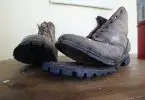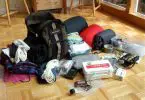One of the best ways to have a safe and exciting trip to an unfamiliar (or familiar!) area is by developing great map reading skills. Maps are readily available from plenty of sources depending on your needs. And they’re not just for backcountry explorers… spending time examining maps can open your eyes to new running or biking routes in your own area that you may have never noticed.
Even with GPS data so readily available to everyone, having the basic ability to read a map is essential for times when satellite signal doesn’t work or the device falls on a rock and breaks. Batteries die. Even if you do choose to use a GPS on the trail, it’s smart to keep a map with you and know how to use it.
Choose Your Map
No matter what your needs are, you can probably find a map that fits them. A map is a visual representation of any kind of data—diagrams for furniture or machinery can be considered a type of map. Here, though, we will focus on maps used for geographic information. There is a tremendous variation in types of available maps.
Since the advent of satellite technology, maps have gotten much more detailed and accurate.
“Plainmetric” maps are useful for simple navigation or traveling along roads and prominent, short trails. These maps typically show roads, trails, towns, and points of interest but this can vary from map to map. An example of a plainmetric map is a highway map.
Most drivers don’t really care how much change in elevation they will be traveling over; they just want to know which roads are which and have the ability to plan the best way to drive somewhere.
For longer outdoor excursions, it’s better to have a topographic map that illustrates terrain and precise elevation measurements. What looks like a very straightforward point A-to-point B line on a plainmetric map might actually include major elevation changes and steep terrain that you would be able to see on a topographic map.
Topographic (“topo”) maps use contour lines to illustrate elevation changes. Some topo maps use shading to enhance the illustration of valleys and hillsides—these are called relief maps. Each contour line represents a specific elevation, measured in feet above sea level.
The distance between contour lines varies by map, but many maps illustrate 50 feet of elevation change between contour lines. Every fifth line, or index line, is bold and the elevation is written along the line.
Basically, the closer the lines are to one another, the steeper the terrain—there is greater elevation change over a shorter distance. This information is useful for planning hikes and choosing backcountry campsites. You can plan ahead and find potentially good campsites by locating flat areas near streams, for example.
A point on the map that doesn’t show much elevation change will likely have suitable places to set up a tent (depending on what the vegetation cover is like).
In some areas where there isn’t enough elevation change to use contour lines, lighter lines can be used to show the shape of the land. Some maps show hachure lines, which are perpendicular to contour lines, to show steepness of slopes. Hachure lines that are closer together illustrate steeper slopes.
Always choose a topo map when planning a backcountry excursion or longer hikes. Trails are not always easy to follow, and a topo map that shows landmarks like mountain peaks and ridges can be indispensable for navigation when the trail isn’t reliable.
See also: Best Garmin GPS: Your Key to Navigating the Toughest Terrains
Many resources exist for getting maps. You can obtain high quality topo maps from the United States Geological Survey (USGS) and the National Geographic Society. Gaia GPS is a good resource for when you want to download a map to your phone and be able to access it offline. National Geographic PDF Quads can be downloaded for free and printed from home. Find the map that works best for you.
Getting to Know Your Map
Learning how to read a map can open up a whole new world of trail exploration and gives you the confidence to travel safely. Hiking and backpacking are a lot more fun when you’re not worried about losing your way.
The first step to getting to know your map is understanding the information it includes.
Map parts to know:
- Scale: Every map includes a scale, which shows how the distance between two points on a map translates to distance between those same two points on the ground. Scale is designated by a ratio. A scale of 1:40,000 means that one inch on the map is equal to 40,000 inches on the ground. The smaller the ratio, the more detailed the map.
- Bar scale: Maps show the scale in the form of a bar scale printed on the map. This shows the translation between the small units of measurement used on the map and the larger-scale distances they represent. For example, a scale might illustrate an inch-long segment and say that map distance represents 1 mile on the map.
You can then measure the distance between two points (as the crow flies or along a trail) and translate this into mileage. Use a piece of string or paper cut to the length of the unit used on the bar to make it easier to account for twists and turns in the trail on the map. - Legend and symbols: Information included on maps can vary greatly. The legend is a key that defines what each map symbol means. Different kinds of roads are illustrated differently on the map; a key shows which colored lines designate each type of road. The legend also defines symbols for features like trailheads, shelters, towns, visitor centers, and points of interest to name a few.
- Latitude and Longitude: Most maps include a grid. In some cases, the grid will correspond to the latitude and longitude of an area. Latitude and longitude lines can be used to navigate anywhere on the globe. Lines of latitude run parallel to the equator, and lines of longitude are perpendicular to the latitude and run from pole to pole.
For smaller scale use, degrees of latitude and longitude can be divided into minutes, seconds and tenths, hundredths, thousandths, etc. of seconds. The edges of the grid on the paper map will note latitudinal and longitudinal locations. This can be useful to find your exact place on the map by cross-checking with a GPS waypoint.
Using Your Map to Plan Routes
Once you’re familiar with what the symbols and lines on your map mean, you can use this information to plan hiking routes. Mountain peaks on topo maps are located where the contour line forms a circle without any more contour lines inside of it.
Sometimes, these peaks are designated with a black X and the elevation. Elevation change can help you predict other landscape features like canyons and waterfalls, and you can identify valleys and ridges by looking at contour lines.
When the lines are stacked in a series of V’s that point toward higher elevation, the space in the middle of the V’s is a valley… or a canyon, depending on how steep the terrain is. When these V’s are stacked pointing toward lower elevation, a ridge follows the course of the middle of the V’s.

Some maps use color to show different land uses, which is very important when planning campsites and where you can and can’t go. In the United States, areas designated federal wilderness have very different regulations than national forests or state parks.
For example, a multi-use mountain bike trail may begin in a national forest area and then continue on into a wilderness area. Because mountain bikes aren’t allowed in wilderness areas, you would have to switch to an alternate means of travel—pack animals or on foot.
Maps also show where private and public land borders are. It is your responsibility to know this information and the use regulations that pertain to the lands you will be crossing.
Color can also be used on maps to show differences in land cover, like intensity of vegetation or lack thereof. For example, varying shades of green can designate varying degrees of dense vegetation to sparse vegetation, all the way up to the bare rock on windswept slopes.
You can use this to help you identify different habitats if you’re looking for specific plants or animals that live in a certain type of habitat. Hunters can use topo and relief maps to predict animal movements depending on the time of year.
One important consideration is that maps can be outdated. Even if a map was published relatively recently, there can be certain features that don’t exist anymore due to natural processes or changes in land use. This goes for trails, bridges and roads among other things.
The United States Forest Service manages an estimated 380,000 miles of roads. Of this, only about one fourth is open to use by passenger cars. Half of the forest service roads are open to vehicles with high clearance, and one fourth is closed to use as public highway.
This being said, it is important to know your vehicle’s capabilities (four-wheel drive, clearance, tire quality) before choosing to drive on some roads. Many maps show the quality of the road in the legend to help you plan your route.
It is also important to note that the Forest Service has identified approximately 60,000 miles of unmaintained and temporary roads within its jurisdiction. Sometimes, just because a map shows it as a road doesn’t mean it is navigable anymore.
Using A Map and Compass for Navigation
If you’re planning on following a trail on your hike, you probably won’t need to take out your compass very much along the route. Nevertheless, it’s an essential tool to keep with you just in case something happens. It can be easy to get disoriented in the forest even if you go off-trail just a short distance.
If you decide to do a little off-trail exploring, knowing how to use a compass to supplement your map is important.
A compass consists of a magnetic arrow mounted in liquid encased by a circle or bezel. This has a rotating ring called the compass dial. The magnetic arrow points to magnetic north, which is different from true north.
True north is at the north pole, but magnetic north is related to the geology of the earth and is actually located about 1,300 miles south of the north pole, in northern Canada. This comes into play when navigating because most maps are aligned along the lines of latitude and longitude, which are related to true north instead of magnetic north.
The compass rose on the map will also show the magnetic north. You need to take the declination, or difference in degrees between magnetic and true north, into account when navigating. The directions on a compass correspond to numbers in a 360-degree circle.
North is 0 or 360 degrees, East is 90 degrees, South is 180 degrees, and West is 270 degrees. These measurements give you a more precise orientation for navigation.
How to Get From Point A to Point B Using a Map and Compass
Step 1: Locate your current position on the map, then find your goal destination on the map. Draw a line between the two points. You don’t have to be able to see your goal point from where you are standing; as long as you can find it on the map then you can get there by following the bearing you will take.
Step 2: Line up the edge of your compass with the line.
Step 3: Rotate the compass dial in order to line up the orienting lines on the compass so that they are parallel with the map’s orienting lines. The orienting lines are the straight lines printed on the inside of the compass dial. Once this step is complete, you have obtained the bearing for the direction of your destination.
Step 4: Hold the compass flat and turn your body until the magnetic arrow is pointing in the same direction as the orienting arrow. Now, you are facing your destination and can navigate there using your compass bearing.
How to Use Triangulation To Locate Your Position on a Map
Even if you don’t know where you are, you can pinpoint your location on a map by identifying distant landmarks and using them to orient yourself on the map.
Step 1: Identify two distant landmarks that you can see from your position. They should be more than 60 degrees apart in order for the triangulation to work.
Step 2: Point the compass at the landmark. Rotate the compass dial until the orienting arrow lines up with the magnetic arrow.
Step 3: Place the compass on your map, touching the landmark on the map. Without touching the dial, rotate the compass so that the compass’s orienting lines line up with the lines on the map.
Step 4: Trace the edge of the compass.
Step 5: Repeat this process with the second landmark. The point where the two lines cross is your location on the map. You can then find the trail or another destination and navigate there using the steps we covered earlier.
While you can find your position using two points, the more landmarks you are able to identify, the more accurate your triangulation will be. Ideally, all of the lines will intersect at one point. But there is always room for error and you might end up with a small polygon at the center of where all of your lines intersect. The more lines you have, the more confident you can be in your actual location.
Staying Oriented On the Trail
A useful habit when hiking with a map is to make notes as you go along to help you remember different features that you might want to come back to or would be able to identify in case of emergency. You can find good potential campsites and mark those to make day-to-day planning a little easier. As you hike, you can try to keep track of how long it takes you to cover a given distance over a certain type of terrain.
If you’re doing an out-and-back hike that is mostly downhill, you will be better able to estimate how long it will take you to hike the return (uphill) trip. Keep in mind the landmarks you can see and where they are on the map. You can even check out the best hiking app to keep you on track.
If you do get lost, the most important thing to do is to stay calm. Chances are, you aren’t off of your intended route by very much and just taking your time and thinking carefully about where you need to go (along with some map and compass work!) can help a lot.
If you are completely turned around and can’t identify any landmarks, you can compare slope changes from where you are standing with the ones on your map. This can help orient yourself along the contour lines of your map to help you get a better idea of which direction is which.
You can leave small markers like rock piles or stick piles along the way to allow you to retrace your steps if needed.
Maps are a fantastic tool for making the most of your time outdoors! One of the best things about maps is that they allow you to see and predict interesting places that could be in your vicinity but maybe not directly off the trail. Becoming confident with map use is one of the most important gifts you can give yourself to have a safe and exciting outdoor adventure.
For more options on navigation, check out our piece on how to choose the best GPS watch before you head on your next adventure.
Featured Image Source: https://pxhere.com/en/photo/1609854







